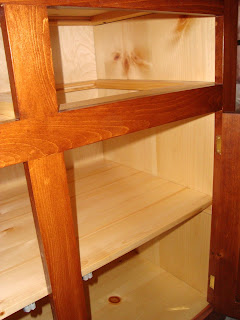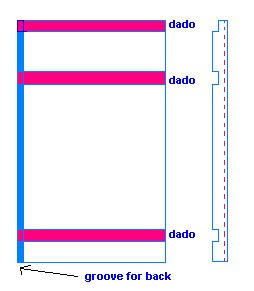Buffet Hutch - Part one - Drawing up the plans
Part two - Same style different finish
Part three - The buffet face frame
Now that we have the face frame, we need the rest of the buffet base to add it on to.
There are two sides and a back and bottom, plus two web frames.
Web frames are horizontal dividers that hold the drawers. You will regularly see web frames in an older style dresser or chest-of-drawers. Newer furniture often uses either a plywood divider or just side rails for the drawers to sit on. The frame is just that, it's shaped like a frame, not solid and allows the drawers to sit on something. It also gives rigidity to the piece and allows for wood movement. I am going to put a web frame at the top to hold the top on and also one below the drawers. Each web frame is 5 pieces I have used 3/4" thick pine. The front, rear and side rails are all 2" wide, the middle rail is 3 1/2" wide. Each end of the side and middle rails has a tongue that fits into a groove in the front and back rails. A few photos might help here.
Web frame being glued up:

Here you can see the tongue and groove that holds the frame together:
These frames will fit into the sides, they won't be nailed there. Nailing through the sides would not only look terrible, it would not give any strength to the piece. The web frames will fit into a groove (dado) cut into the sides to hold them in place.
Now on to with the sides, which I have made out of pine-veneered particle core. You could also use pine-veneered plywood, which I might use next time. The plywood is lighter, but also has the tendency to warp, and I couldn't find a good supply of it locally.
As I said earlier, the sides are dadoed to let the frames sit into them. The dadoes are at the proper height to allow the face frame and web frame to line up so that the drawer can slide in and sit on it. The bottom of the face frame drawer opening must hit the top of the web frame (this is why you don't make up all your parts first and why you need to be accurate to 1/32").
Here you can see where the web frame inside meets the face frame:
So I will need a 3/4" wide groove at the top and then another one approx. 7" down from the top to fit the two web frames into.
Also I am putting in a bottom of pine PC, so I need a dado to hold that as well. My pine PC is 11/16" thick, so that dado is equally 11/16" to hold the bottom piece.
A groove is needed down the back edge for the ply back, which is 1/4" thick. So this is what the right side piece will look like, don't forget that the left side will be a mirror image and not the same. (Immediately to the right of this diagram is a side view image.)
For the inside of my buffet I used a few coats of shellac and put the coats on before I glued the pieces together. This makes things go together much easier, because it's hard to get into corners when it's all glued together. In woodworking you really do have to think a few steps ahead.
We can then glue up the base with the two sides, two web frames and bottom piece. I leave the back off for now so that I can put the shelf inside first. Unfortunately I didn't take photos of this process, but I'll try and create something basic using the Paint program that I've been using for these crude sketches. As I said earlier, I draw most of my creations by hand.
Note: this is not to scale, and poorly done, but I hope it gives some idea of what you will have this far.
An important note. My face frame clips over the sides, as I've explained earlier. So it doesn't just butt up to the side edges, it goes over them. This means the web frames and bottom piece have to sit back 3/8" from the side edges so that the web frames will butt up to them. I hope this isn't too confusing. Here comes another sketch...
Ok, enough for today. Next we will work on the drawers and doors. Please feel free to ask questions, I will reply below the messages.
Continue on to: Part five - Drawers








I see your frame but there appears to be no sheet of plywood attached. Back the middle of the last century, the plywood was considered a part of better furniture and we were always persuaded that it was to keep the clothes in the drawers clean by stopping dust and such from falling on the clothes from above. Were we wrong?
ReplyDeleteThanks for reading, MJ. I've always thought that they should be made without any plywood fill in. I think that's why they are called "web" frames. Like a spider's web, not filled in! But also, I do believe they allow for more air flow between the drawers.
Delete